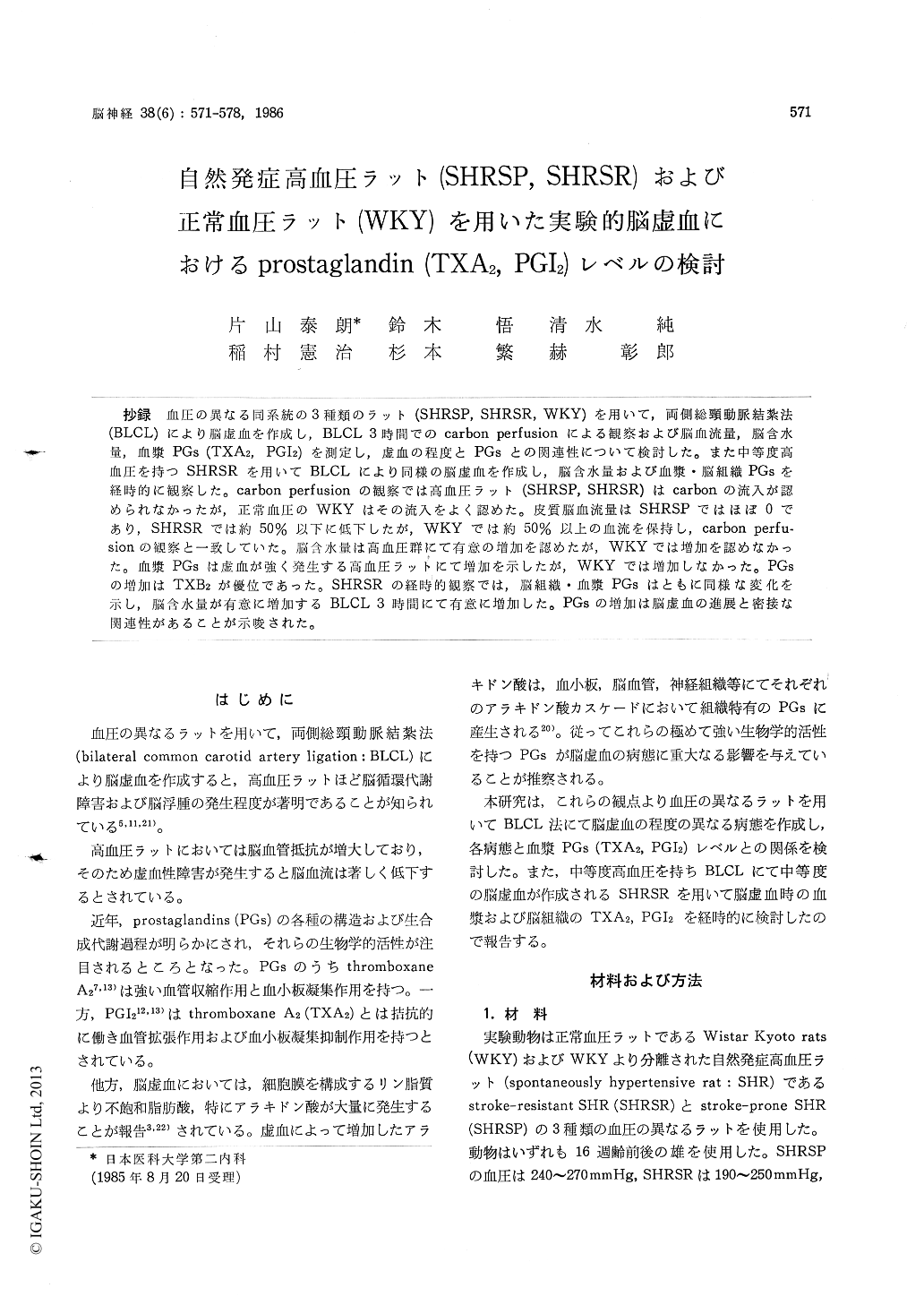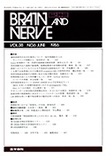Japanese
English
- 有料閲覧
- Abstract 文献概要
- 1ページ目 Look Inside
抄録 血圧の異なる同系統の3種類のラット(SHRSP,SHRSR,WKY)を用いて,両側総頸動脈結紮法(BLCL)により脳虚血を作成し,BLCL 3時間でのcarbon perfusionによる観察および脳血流量,脳含水量,血漿PGs (TXA2,PGI2)を測定し,虚血の程度とPGsとの関連性について検討した。また中等度高血圧を持つSHRSRを用いてBLCLにより同様の脳虚血を作成し,脳含水量および血漿・脳組織PGsを経時的に観察した。carbon perfusionの観察では高血圧ラット(SHRSP,SHRSR)はcarbonの流入が認められなかったが,正常血圧のWKYはその流入をよく認めた。皮質脳血流量はSHRSPではほぼ0であり,SHRSRでは約50%以下に低下したが,WKYでは約50%以上の血流を保持し,carbon perfu-sionの観察と一致していた。脳含水量は高血圧群にて有意の増加を認めたが,WKYでは増加を認めなかった。血漿PGsは虚血が強く発生する高血圧ラットにて増加を示したが,WKYでは増加しなかった。PGsの増加はTXB2が優位であった。SHRSRの経時的観察では,脳組織・血漿PGsはともに同様な変化を示し,脳含水量が有意に増加するBLCL 3時間にて有意に増加した。PGsの増加は脳虚血の進展と密接な関連性があることが示唆された。
Three different levels of global forebrain ische-mia were induced in rats and their plasma levels of Thromboxane B2(TXB2) and 6 Keto PGF1α were determined to investigate the relation between severity of ischemia and eicosanoid production.
Ischemia stimulates the activity of cellular lipase whose actions cause deacylation of brain phospho-lipids and release of free fatty acids. Arachidonic acid (A.A.) is one of the predominant fatty acids which is liberated in brain after ischemia. A.A. is the primary substrate for the synthesis of Pro-staglandins (PGs), Thromboxane A2 (TXA2) and Prostacyclin (PGI2), which play an important role in regulation of platelet aggregation and vaso-tonus. Thromboxane is a potent platelet aggregator and vasoconstrictor. On the other hand, PGI2 has the opposite nature. Therefore it can be con-sidered that PGs and moreover, the balance of TXA2 and PGI2 may have an intimate relation to the development of cerebral ischemia.
Three different levels of ischemia were produced by bilateral carotid artery ligation (BLCL) using three kinds of rats with different blood pressure ranges, namely, SHRSP (Stroke-prone spontan-eously hypertensive rats), SHRSR (Stroke-resistant spontaneously hypertensive rats) and WKY (Wis-tar kyoto rats). It is known that higher pressure groups suffer severe ischemia by BLCL procedure. Hypertensive rats (SHRSP, SHRSR) were origin-ally produced from WKY. The experimental animals used were about 300gr and 16 weeks old male rats. The plasma and brain TXB2 and 6 Keto-PGF1α, stable metabolites of TXA2 and PGI2 were measured by radioimmunoassay. The chronological changes of brain and plasma PGs levels after ischemia using SHRSR were also investigated.
Colloidal carbon perfusion was performed on rats 3hr. after BLCL. CBF and brain water content were measured and compared to the PGs levels.
In the hypertensive groups (SHRSP and SHRSR), colloidal carbon perfusion showed a markedly disturbed pattern, whereas the carbon was well filled in normotensive WKY.
The hypertensive rats (SHRSP, SHRSR) demon-strated severe decrease of CBF with increase of brain edema 3hr. after BLCL. While the normo-tensive rats showed only slight decrease of CBF and did not have increase of water content. Plasma TXB2 3hr. after BLCL showed a significant increase in the hypertensive groups but no change was observed in normotensive WKY. On the other hand, 6 Keto PGF1α showed a similar increase in these three groups of rats. On the periodical observation using SHRSR, plasma TXB2 contin-uously increased after BLCL and was significantly increased after 3 hr. of BLCL. 6 Keto PGF1α, show-ed a continuous increase but the increase was slight compared to that of TXB2. The cerebral tissue TXB2 and 6 Keto PGF1α also showed a remarkable increase at 3 hr. after BLCL but the increase was more prominent in TXB2.
The increase of TXA2 and the priority of TXA2 over PGI2 were demonstrated in the plasma and tissue of the hypertensive groups of rats which suffered a more severe ischemic damage by BLCL. It may play an important role in deve-loping ischemia due to the biological activities of TXA2.

Copyright © 1986, Igaku-Shoin Ltd. All rights reserved.


